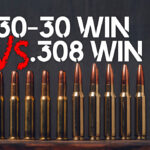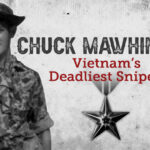
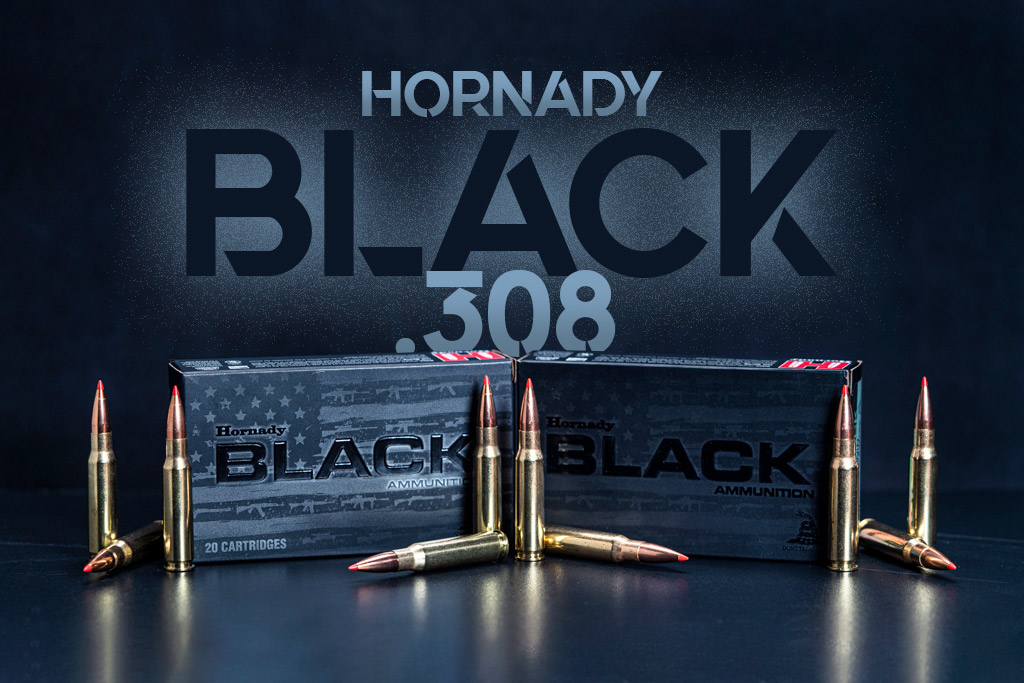
The .308 Win is unquestionably one of the most popular cartridges in production. However, not all .308 cartridges are created equal. The best .308 cartridges feature cutting-edge designs, precision manufacturing processes, and top-quality primers, propellants, and cases. A prime example is the Hornady Black .308 cartridge, which rapidly developed a reputation for being ultra-reliable for match settings.
Below, we’ll explore the Hornady Black .308 lineup. Including ballistic performance and key design features. Since this .308 cartridge is currently offered in two different projectile weights, we’ll compare the 155-grain and 168-grain options. Let’s take a look below.
What Is Hornady Black Ammo?
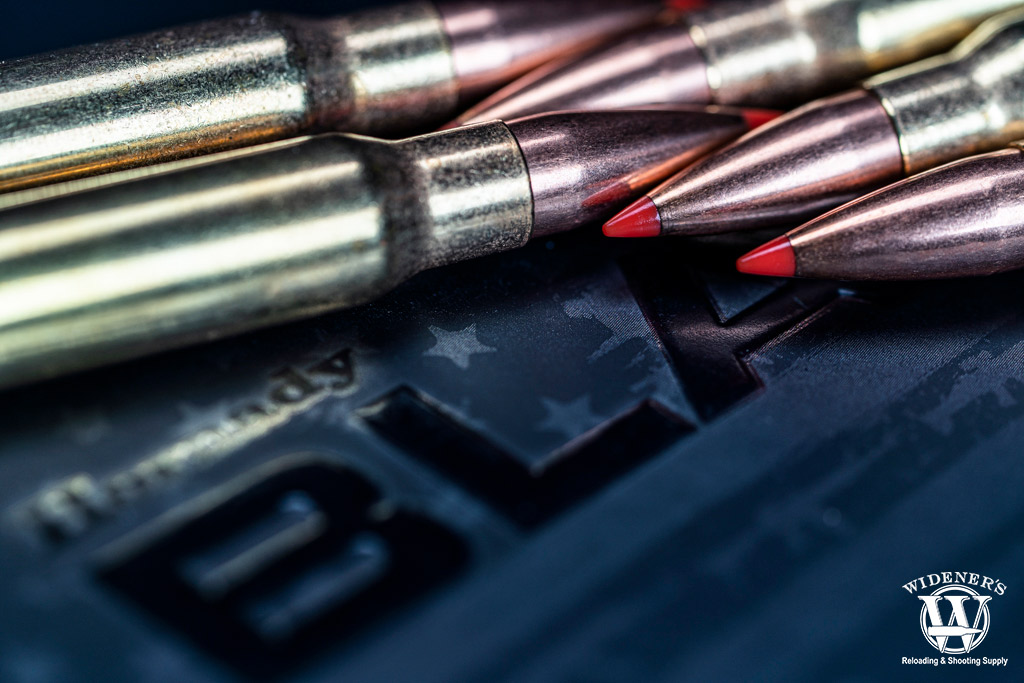
Hornady Black 308 ammo features poly-tipped A-Max bullets designed for match-grade performance.
Hornady has several different product lines, including Critical Defense, Full Boar, Precision Hunter, and the Dangerous Game Series. All of these lines are known for offering superior reliability and performance. However, the Hornady Black cartridge is one of the most versatile and accurate. This cartridge can be used with direct impingement weapons, gas piston platforms, carbines, pistols, mid-length rifles, suppressed firearms, and more.
Put simply, Hornady Black was designed for use in modern sporting rifles and pistols. Currently, Hornady Black is available in several popular calibers. Including .223, 6mm Creedmoor, 6.5 Grendel, 6.8 SPC, .300 Blackout, and of course, .308 Winchester. In addition, it is offered in 9mm, .45 ACP, .40 S&W, and 12 gauge.
Hornady uses different bullets in its “Black” product lineup, depending on the caliber and intended application. For this article, we will focus on the projectile used in the Hornady Black .308 cartridge, which is the A-MAX. As noted earlier, the .308 Black cartridges are designed for match shooting. However, Hornady does offer Black cartridges in other calibers for hunting applications.
Like many other Hornady projectiles, the A-MAX sports the immediately recognizable red tip. The polymer tip is designed to optimize expansion upon impact. Additionally, the tip enhances stability while the projectile is in flight.
The A-MAX features an ogive profile, which aids in drag reduction and helps flatten out the bullet’s trajectory. This projectile has a “swaged” lead core as well. Swaging is a metal shaping process that Hornady uses to create a uniform bullet shape during production.
The back end of the A-MAX incorporates a boattail design. The length and angle of the boattail will vary depending on the bullet weight and caliber.
Cartridge Comparison
Now that we have covered the basics of the Hornady Black cartridge product lineup, let’s focus on the two .308 offerings. Hornady Black 308 features the 155-grain and 168-grain variants. Our ballistic data examples below are taken from a 24″ test barrel.
Hornady Black 308 155gr A-Max

Hornady Black 308 155gr A-Max ammo has a ballistic coefficient of .435 (G1).
The 155-grain Hornady Black .308 cartridge is the lighter of the two offerings. This projectile has a muzzle velocity of 2,850 feet per second (FPS). At the 100-yard mark, this figure drops to approximately 2,639 fps according to Hornady. This figure continues to decline by approximately 190 fps for every 100 yards the projectile travels. At 500 yards, the 155-grain projectile has a listed muzzle velocity of 1,887 fps.
The projectile leaves the muzzle with a listed energy of 2,795-foot-pounds. At 100 yards, this figure declines to 2,397 ft-lbs. By the 300-yard threshold, the projectile’s energy is 1,735 ft-lbs., which is very respectable.
Since the 155-grain Hornady Black .308 cartridge is designed for match shooting, the most important performance factor is its trajectory. Flat is where it’s at. The bullet has a trajectory of 1.8 inches at 100 yards and a trajectory differential of 0 at 200 yards. This figure declines to negative 7.6 inches at 300 yards and negative 22.1 inches at 400 yards.
| Caliber | Bullet Type | Bullet Weight | Velocity (Muzzle) | Energy (Muzzle) | 100 Yards (Velocity/Energy) | 200 Yards (Velocity/Energy) | 300 Yards (Velocity/Energy) |
|---|---|---|---|---|---|---|---|
| .308 Win | A-Max Polymer | 155gr | 2,850 FPS | 2,795 FT LBS | 2,639 FPS/2,397 FT LBS | 2,438 FPS/2,045 FT LBS | 2,245 FPS/1,735 FT LBS |
Hornady Black 308 168gr A-Max
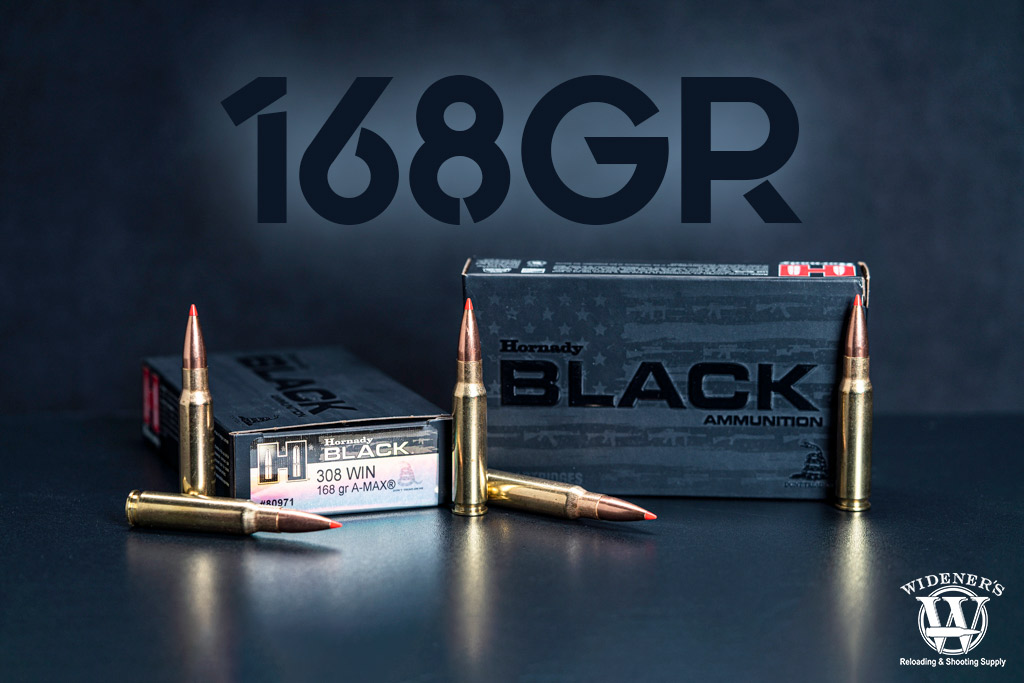
Hornady Black 308 168gr A-Max ammo has a ballistic coefficient of .475 (G1).
The 168-grain Hornady Black .308 cartridge exhibits excellent performance but falls just behind the 155. This heavier cartridge has a muzzle velocity of 2,700 fps. The projectile’s velocity declines to 2,513 fps at 100 yards. However, it holds it’s own at 2,333 fps at 200 yards, and 2,161 fps at 300 yards. By the time the projectile arrives at the 500-yard threshold, the velocity is 1,839 fps.
From the muzzle, the 168-grain Black cartridge produces 2,719 ft-lbs. of energy. This figure drops to 2,355 at 100 yards, 2,030 at 200 yards, and 1,742 at 300 yards.
Like the 155-grain, the 168-grain Hornady Black projectile has a 0 trajectory at 200 yards. However, this is the only instance when the trajectory of the heavier projectile aligns with that of the lighter bullet.
At 100 yards, the 168-grain has a trajectory of 2 inches. The 300-yard trajectory is negative 8.4 inches and the 400-yard trajectory is negative 24.3 inches.
| Caliber | Bullet Type | Bullet Weight | Velocity (Muzzle) | Energy (Muzzle) | 100 Yards (Velocity/Energy) | 200 Yards (Velocity/Energy) | 300 Yards (Velocity/Energy) |
|---|---|---|---|---|---|---|---|
| .308 Win | A-Max Polymer | 168gr | 2,700 FPS | 2,719 FT LBS | 2,513 FPS/2,335 FT LBS | 2,333 FPS/2,030 FT LBS | 2,161 FPS/1,742 FT LBS |
155-Grain VS 168-Grain Cartridges
So which grain weight option is best? That largely depends on what you plan to use the ammo for. During our head-to-head comparison, the 155-grain Hornady Black .308 cartridge consistently outperformed the 168-grain alternative. The 155-grain bullet has a faster muzzle velocity and maintains a higher velocity at every measurement threshold.
In terms of energy, the 155 grain is the frontrunner for the first 200 yards. From the 300-yard mark onward, the 168-grain has more energy, but the difference is negligible.
Finally, the 155-grain .308 cartridge has a flatter trajectory at every measurement point, with the exception of the 200-yard mark. For match-shooting purposes, flatter trajectories facilitate better accuracy. While 0.8 inches (-7.6 in. vs. -8.4 in.) may not seem like much at 300 yards, this variation could mean the difference between 1st place and runner-up in a competition setting.
Hunting Considerations
The 168-grain Black cartridge does make sense as a hunting round. The A-Max bullet is no slouch when it comes to medium-big game hunting. With many hunters embracing the AR-10 platform, this versatile round takes center stage. Its expanding capabilities in soft targets are brutal and put game down on the ground for good. Deer and elk hunters tired of tracking game through the underbrush, take note.
Barrels with a twist rate of 1:10-1:12 will handle the 168-grain Black rounds just fine. Barrels 20″ or greater will perform better with the round at long distances.
At 300-yards, you’re still getting velocities over 2,000 FPS with 1,742 ft-lbs of energy. Compare that to .308 Remington Core-Lokt 180gr SP. Which slows to 1,667 FPS, and 1,111 ft-lbs at 300-yards. We’re talking serious damage to anything unlucky enough to cross the path of the bullet. As we mentioned, your accuracy may vary, depending on the length and quality of your barrel. However, groupings in the 1-1.5″ range can be expected at 100-yards.
Hornady: A History of Excellence
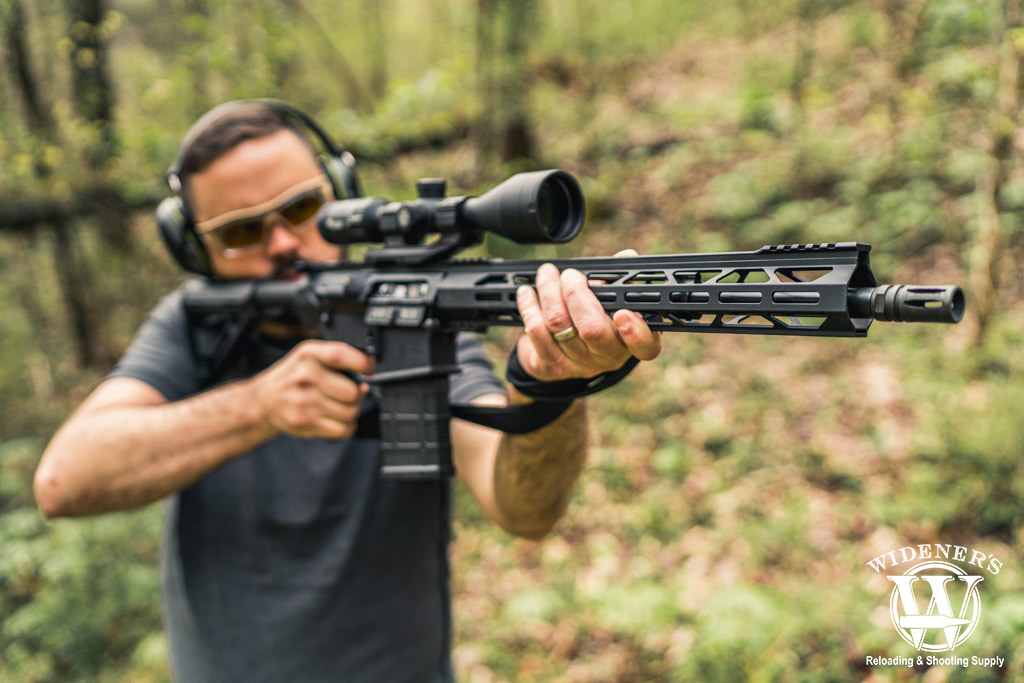
Hornady has been manufacturing quality ammo right here in the USA for more than 60 years.
The Hornady Manufacturing Company can trace its roots back to World War II. At that time, founder Joyce Hornady relocated to Grand Island, Nebraska. He began training security forces at the Grand Island Arsenal. Naturally, Hornady instructed participants on the key tenets of marksmanship.
There’s a big difference between shooting bullets and manufacturing them. Joyce set out to do just that. Ambition will only get you so far. You’ll need the talent to take you the rest of the way. Four years after the war, Hornady founded his ammo manufacturing company.
While plenty of excess ammunition remained from wartime production, none of it was designed for hunting. Hornady wanted to fill this void in the ammunition market. He did so by creating the company’s flagship projectile. The 150-grain, .30 caliber bullet with a spire point was born. Incredibly, it remains a popular option to this day.
Over the next 9 years, Hornady continued to grow and ultimately relocated to a new facility in 1958. The manufacturer remains at this 8,000-square-foot location to this day. The facility includes a 200-yard underground test facility, which offers an ideal proving ground for its projectiles.
Are you a hunter? Be sure to check out the best .308 ammo for deer also on the blog.


